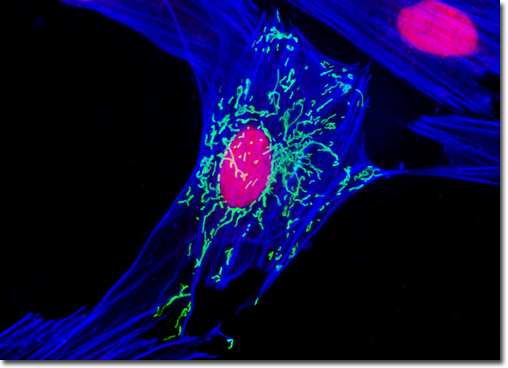Fluorescence Digital Image Gallery
Indian Muntjac Deer Skin Fibroblast Cells
|
Part of the popular SYTOX line of nucleic acid stains, SYTOX Orange is cell impermeant, only penetrating the compromised plasma membranes characteristic of dead cells. Thus, the cyanine dye is often used as a simple, single-step dead-cell assay, though it also performs well as a counterstain in multicolor applications and in DNA fragment sizing studies utilizing single-molecule flow cytometry. When SYTOX Orange binds to DNA, the dye’s fluorescence is enhanced more than 500-fold. In this bound state, the SYTOX Orange/DNA complex exhibits an absorption maximum of 547 nanometers and emission maximum 570 nanometers. The culture of Indian Muntjac deer skin cells that is presented in the digital image above was labeled with SYTOX Orange and Alexa Fluor 350 conjugated to phalloidin, which target DNA and filamentous actin, respectively. In addition, the cells were transfected with a pEYFP-Mitochondria plasmid subcellular localization vector, thus localizing a yellow fluorescent protein tag to the intracellular mitochondrial network. Images were recorded in grayscale with a QImaging Retiga Fast-EXi camera system coupled to an Olympus BX-51 microscope equipped with bandpass emission fluorescence filter optical blocks provided by Omega Optical. During the processing stage, individual image channels were pseudocolored with RGB values corresponding to each of the fluorophore emission spectral profiles. |
© 1995-2025 by Michael W. Davidson and The Florida State University. All Rights Reserved. No images, graphics, software, scripts, or applets may be reproduced or used in any manner without permission from the copyright holders. Use of this website means you agree to all of the Legal Terms and Conditions set forth by the owners.
This website is maintained by our
|
